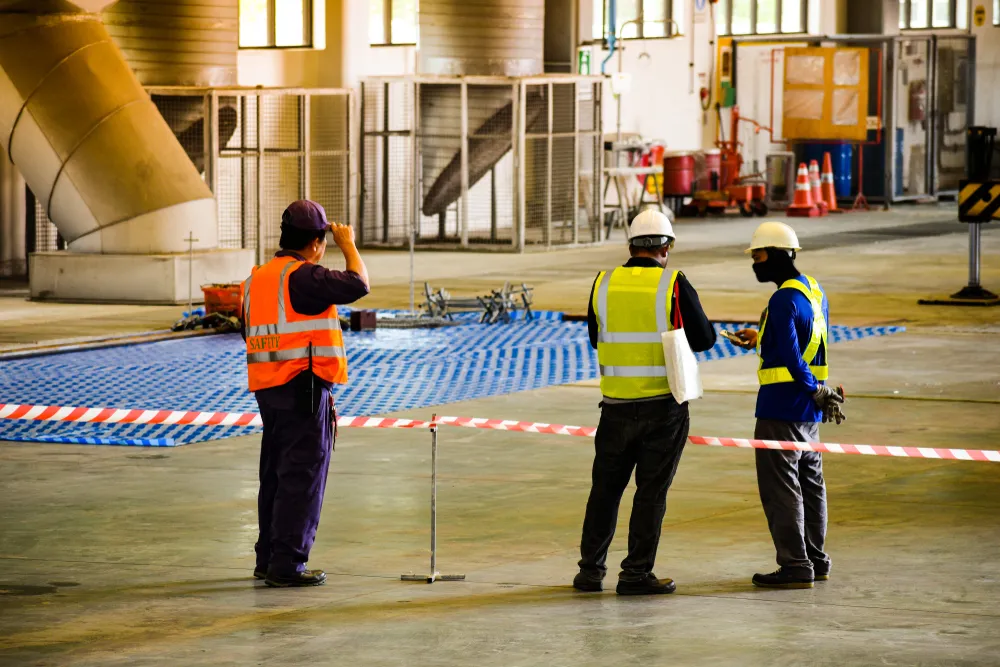Getting The Roar Solutions To Work
Getting The Roar Solutions To Work
Blog Article
The Of Roar Solutions
Table of ContentsThe Main Principles Of Roar Solutions Excitement About Roar SolutionsAll about Roar Solutions
In order to secure installations from a prospective surge a technique of analysing and categorizing a possibly unsafe location is required. The function of this is to make sure the appropriate choice and installment of equipment to eventually stop an explosion and to make certain safety of life.
(https://pinshape.com/users/7197164-roarsolutions#prints-tab-open)
No equipment must be installed where the surface temperature of the equipment is more than the ignition temperature level of the given threat. Below are some common dirt hazardous and their minimal ignition temperature level. Coal Dust 380C 225C Polythene 420C (melts) Methyl Cellulose 420C 320C Starch 460C 435C Flour 490C 340C Sugar 490C 460C Grain Dirt 510C 300C Phenolic Material 530C > 450C Aluminium 590C > 450C PVC 700C > 450C Soot 810C 570C The possibility of the risk existing in a concentration high adequate to trigger an ignition will certainly vary from place to location.
In order to identify this risk a setup is split into locations of risk relying on the quantity of time the harmful exists. These locations are referred to as Areas. For gases and vapours and dirts and fibers there are three zones. Zone 0 Area 20 A harmful atmosphere is very likely to be present and may be existing for lengthy durations of time (> 1000 hours annually) or perhaps continuously Zone 1 Zone 21 A hazardous environment is possible but unlikely to be present for long durations of time (> 10 450 C [842 F] A classification of T6 implies the minimum ignition temperature is > 85 C [185 F] Harmful area electrical equipment perhaps made for usage in higher ambient temperature levels. This would certainly indicated on the score plate e.g. EExe II C T3 Ta + 60C( This implies at 60C ambient T3 will not be gone beyond) T1 T1, T2, T3, T4, T5, T6 T2 T2, T3, T4, T5, T6 T3 T3, T4, T5, T6 T4 T4, T5, T6 T5 T5, T6 T6 T6 A T Course rating of T1 implies the maximum surface area temperature level generated by the instrument at 40 C is 450 C. Assuming the connected T Course and Temperature rating for the tools are ideal for the location, you can always use a tool with an extra rigid Division ranking than required for the area. There isn't a clear solution to this concern sadly. It truly does depend upon the kind of equipment and what repairs need to be lugged out. Tools with details examination procedures that can not be carried out in the area in order to achieve/maintain 3rd party ranking. Must come back to the manufacturing facility if it is before the equipment's solution. Field Repair By Authorised Worker: Complex screening might not be needed nonetheless certain procedures may require to be adhered to in order for the equipment to maintain its third party rating. Authorised employees need to be used to execute the work correctly Repair service must be a like for like replacement. New part have to be considered as a direct replacement needing no special screening of the tools after the repair service is total. Each tool with an unsafe rating need to be assessed individually. These are outlined at a high level below, however, for more thorough info, please refer directly to the guidelines.
The Single Strategy To Use For Roar Solutions
The tools register is a detailed data source of equipment documents that includes a minimum collection of areas to identify each thing's location, technological criteria, Ex classification, age, and ecological data. This details is essential for monitoring and managing the tools properly within dangerous locations. In comparison, for regular or RBI tasting inspections, the quality will be a combination of Detailed and Close assessments. The proportion of In-depth to Close assessments will be established by the Devices Risk, which is evaluated based upon ignition risk (the likelihood of a source of ignition versus the chance of a flammable ambience )and the dangerous area classification
( Zone 0, 1, or 2). This variant will also influence the resourcing requirements for work preparation. As soon as Whole lots are specified, you can create sampling plans based upon the example size of each Whole lot, which describes the number of arbitrary equipment items to be checked. To determine the called for example dimension, two aspects need to be reviewed: the size of the Lot and the group of examination, which indicates the degree of effort that should be applied( lowered, typical, or increased )to the evaluation of the Whole lot. By integrating the group of examination with the Great deal size, you can after that establish the ideal being rejected requirements for an example, indicating the allowable number of damaged things discovered within that sample. For even more details on this procedure, please describe the Power Institute Guidelines. The IEC 60079 conventional advises that the optimum interval in between evaluations must not exceed three years. EEHA examinations will certainly likewise be performed outside of RBI projects as part of scheduled maintenance and equipment overhauls or fixings. These inspections can be attributed toward the RBI example sizes within the affected Great deals. EEHA evaluations are conducted to identify mistakes in electrical devices. A weighted racking up system is vital, as a single item of tools may have several faults, each with varying levels of ignition danger. If the combined rating of both examinations is much less than two times the fault rating, the Whole lot is deemed appropriate. If the Whole lot is still taken into consideration undesirable, it must undertake a full assessment or justification, which might cause stricter assessment procedures. Accepted Whole lot: The reasons for any type of faults are determined. If an usual failure setting is found, extra tools may require inspection and repair. Mistakes are classified by intensity( Safety, Honesty, House cleaning ), ensuring that urgent issues are evaluated and resolved without delay to alleviate any effect on safety and security or procedures. The EEHA database must track and tape the lifecycle of faults together with the restorative activities taken. Applying a durable Risk-Based Evaluation( RBI )strategy is vital for making certain compliance and safety and security in managing Electrical Equipment in Hazardous Areas( EEHA) (Roar Training Solutions). Automated Mistake Rating and Lifecycle Administration: Easily handle mistakes and track their lifecycle to boost inspection precision. The introduction of this support for risk-based evaluation further reinforces Inspectivity's setting as a best-in-class option for regulatory conformity, in addition to for any kind of asset-centric evaluation use case. If you want finding out more, we welcome you to ask for a presentation and discover exactly how our remedy can transform your EEHA monitoring procedures.
Not known Details About Roar Solutions

In terms of eruptive risk, a harmful location is a setting in which an explosive environment is present (or might be expected to be present) in quantities that require special safety measures for the building and construction, setup and use devices. hazardous area electrical course. In this post we discover the obstacles encountered in the office, the risk control actions, and the needed proficiencies to work securely
It is a repercussion of modern-day life that we make, save or take care of a variety of gases or fluids that are regarded combustible, and a range of dirts that are regarded combustible. These materials can, in particular conditions, form explosive atmospheres and these can have significant and heartbreaking effects. The majority of us are acquainted with the fire triangular remove any type of among the 3 components and the fire can not happen, however what does this mean in the context of dangerous areas? When damaging this down right into its easiest terms it is essentially: a mix of a particular amount of release or leakage of a particular material or product, blending with ambient oxygen, and the visibility of a source of ignition.
In most circumstances, we can do little concerning the levels of oxygen airborne, however we can have significant influence on sources of ignition, for instance electric equipment. Dangerous areas are documented on the unsafe area classification illustration and are recognized on-site by the triangular "EX" sign. Below, among other crucial info, zones are split right into three types depending on the hazard, the chance and duration that an eruptive ambience will certainly exist; Zone 0 or 20 is considered one of the most dangerous and Area 2 straight from the source or 22 is considered the least.
Report this page